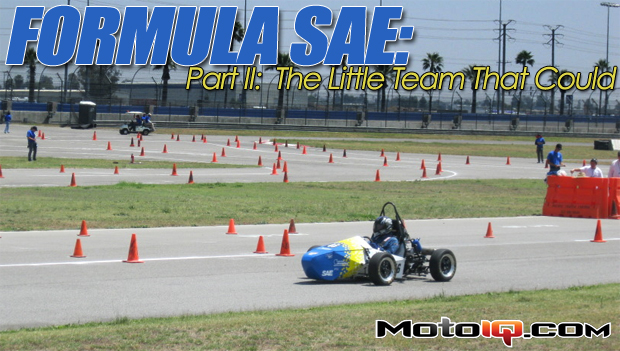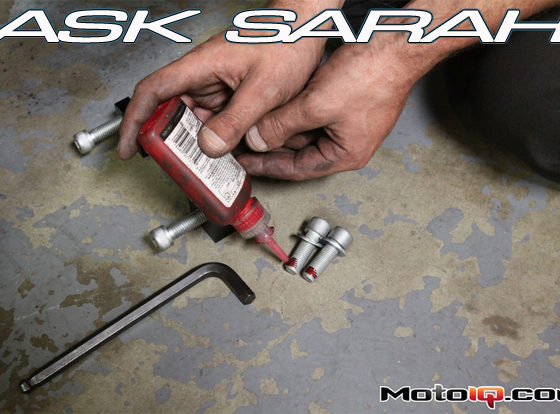,
The engine had been of great service to the team since 2008, until a routine oil change uncovered a devastating problem: a clutch retaining bolt had backed out while the car was being dyno tuned and had been digging into the engine cover, sending thousands of tiny aluminum shavings throughout the engine. Everything from the head, to the piston, to the oil pump were ravaged by the bits of metal. After long deliberation, the team decided to switch over to a newer YFZ450R. The R already comes fuel injected, so the custom work required to make the old engine run EFI would not be needed. Simply wire the OEM sensors into the wiring harness, and off you go! Well it would be that easy, except the blocks of the two engines are very different and required new engine mounts, new diff mounts, a tweaked wiring harness, and a number of plumbing changes before it could run.
 |
| The new motor in its final home.Yes there is a lot of room around the engine; when the car was designed, there were supposed to be a few more auxiliary tanks and an oil cooler, but with the new R engine, these were no longer necessary. Note the finished exhaust and how nicely it follows the frame. This is a very quiet car. The JEGS overflow tanks are inexpensive and in stock, plus they include draining petcocks. Also note the swirl pot on the upper right side of the frame. This car runs amazingly cool for using a stock YFZ radiator. |
For example, the R has an internal oiling system, whereas the non-R uses an external tank. The engine mounts are also slightly different, requiring new mounts to be fabricated. Lastly, the new engine is a few pounds heavier, so its placement would have to be shifted a bit to optimize the weight distribution. This happened in early March, and the car would have to be rebuilt by the end of May. A Herculean effort went into getting the new engine installed and running. Because this new engine was not stroked or bored, a new engine tune was also quickly worked out to make the new engine run properly. In a little over 3 months, the team was able to work out all of these issues, finish the car, and even squeeze in a few test days. While losing an engine this late in the season was a major setback, Delaware would overcome the problem and finish relatively well.
 |
A stock YFZ injector is used. A custom block was made to fit the injector to the A/N line. Yes, the intake is very nasty looking. It’s our test intake for tuning plenum size. |
Moving back to the design of the car, we arrive at the fueling system. Because the car is restricted, a stock Yamaha fuel injector from the YFZ450R is used. An Aeromotive fuel pressure regulator controls pressure. All the hose is plumbed with -4 A/N line. The fuel tank is custom built from aluminum and houses an in-tank fuel pump. The tank features a vented cap with a discriminator, a sight tube for fillups, and all A/N fittings on stainless steel lines. The tank is designed to be light and large, maximizing the space inside the car. The inside is filled with a porous, spongy material to help prevent fuel sloshing and starvation. Because the pump is top fed from the very bottom of the tank, fuel starvation should not be a major issue, except at very low fuel levels. The tank holds about two gallons.
 |
Aeromotive adjustable FPR for controlling fuel pressure. When this car rolls into ACS in June, this will be held in with bolts, not zip ties. Yes, it’s a JEGS gauge. Pooshrod suppliers tend to have lots of parts in stock which makes getting stuff in a hurry easy. |
 |
Safety is job number one, which is why this sturdy aluminum firewall was built to protect the driver from any fluid spills (the fuel tank backs up to this plate and the seat rests over it). The beautiful tin work was done by team member Seth and he spent many hours getting it to fit perfectly. It is affixed with zip-ties and Velcro and can be removed in a matter of minutes if there is any issue with the fuel system. |
The intake is also custom built. Rules stipulate that cars running on race gas must have a 20mm intake restrictor (cars running E85 only get 19mm). The restrictor is molded into the intake. Previous intakes were designed using basic fluid dynamics and some CFD. This year’s intake was designed using good old fashioned testing. The intake currently on the car is a test intake with removable plenum sections. This engine has spent many hours on the dyno testing plenum size for maximum power and best throttle response. The idea of the plenum is to give the engine good throttle response. When the throttle is closed the engine can still have a fresh source of air for a few moments before the driver pins the go pedal again. This prevents the engine from bogging while the intake refills with fresh air. With plenum size set, the team will create a PVC mold and form a final intake from carbon fiber. This intake will include the plenum, restrictor, and fuel injector boss. The throttle body is custom machined from aluminum. It is kept small to keep intake velocity high and weight low.



